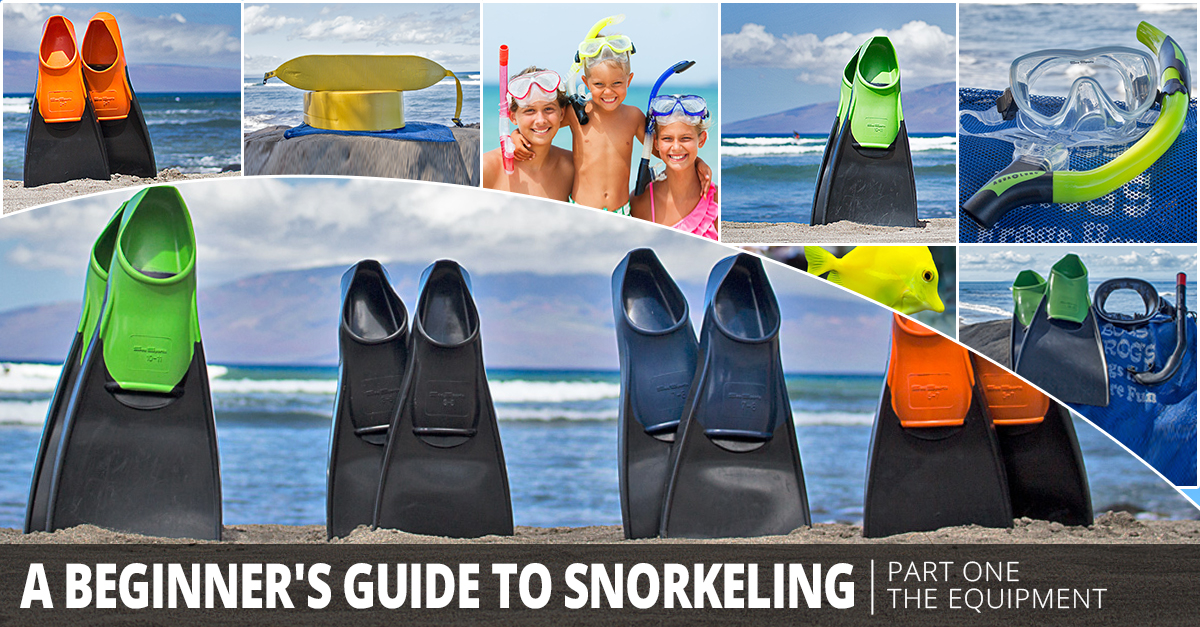
E komo mai, ocean adventurers! (Welcome!) This is your snorkeling guide.
Are you interested in snorkeling? Maybe you’ve haven’t yet tried the sport. Perhaps you last spent time on the surface of the ocean years ago. Or, you may already consider yourself an expert! Wherever you’re floating on the snorkeling spectrum, you’re likely to discover some helpful information below. I’ve been snorkeling for over a decade, and I was excited to learn some new things while working on this snorkeling guide and the next.
In today’s installment, we’ll explain snorkeling gear from top to bottom, so please . . . swim on!
The Turtle and the Hair

These snorkelers have most of their hair tied back properly, but the mask straps should be higher on their heads. For the best seal, the strap goes above – or directly on top of – the ponytail.
This probably isn’t the first thing that comes to mind when you think of exploring the ocean, but before we consider your mask, this snorkeling guide is going to talk about your hair. If your hair has ever gotten into your eyes, you’ll want to push it out of the way with a snug, flexible hairband. If you can gather your hair into a ponytail or a braid – do that, too. You don’t want it getting in your way while you’re looking at things underwater.
Now, on to facial hair! A mustache can break an otherwise tight seal in your mask, causing water to enter. The best thing to do is shave to just above the seal of the mask, so that the mask touches your skin, instead. A less effective way to handle(bar) the situation is to spread petroleum jelly onto your mustache before getting wet. This should create a decent barrier. Whatever you do, don’t smile! (No having fun in the water; I mean it!) I’m half kidding about that, but it can be difficult not to grin while snorkeling. Thankfully, a couple of drops of laughter-induced water never hurt anyone!
FYI, if you have a full beard, your mask is going to leak slowly. That’s all right, and it can’t be helped. Keep reading to learn how to defog your mask while you’re on the go.
Your Dive Mask

Whether you’ve got facial hair, long hair, or no hair, be sure to choose a dive mask that fits your unique, beautiful face.
Here’s how to select the right one for you:
- Pick up the mask, flip the strap forward to get it out of the way, and place the mask onto your face.
- Inhale through your nose, let go of the mask, and shake your head from side to side. If the mask stays on, you’ve found a good fit. If it falls off after two tries, test others until you find one that stays put.
When you are in the water, the inside of your mask can fog up. This defeats the purpose of snorkeling, because you lose the ability to see all the cool animals. To avoid that disappointment, make note of this crucial tip from our snorkeling guide: add defog to your mask on land – while everything is still dry.
Use clean fingers to rub a drop or two of baby shampoo onto the inside of your mask lens. Cover the lens completely. Quickly rinse the mask by dipping it in water. Shake out the extra drops, immediately put the mask on your face, and secure the strap so that it is on the upper third of the back of your head. Do not remove the mask. If you do, moisture will sneak in, and your mask will fog up. After putting on your mask, get in the water ASAP. This should give you a clear view for your entire adventure.
In case something comes up and I do have to take my mask off, I swim out with a miniature bottle of baby shampoo tucked into my bathing suit. A second application offshore doesn’t work as well as the initial, land-based rub-and-rinse, but it’s better than nothing. Spit can also work for a short time, and you’ll always have that!
The Snorkel Itself
When you are snorkeling, you will breathe through your mouth only. Your nose will be covered by your mask, so it will be unavailable for respiratory duties. (I’ll bet you didn’t know you were practicing your snorkeling skills every time you had a head cold! Golly, you’re halfway there!)
The J-Tube is the most basic snorkel model. As you might imagine, this rigid plastic pipe looks like the letter “J.” There is a mouthpiece on the bottom (the curved end of the J) to hold between your teeth. The sky end of the J-Tube is sheared off horizontally.
A fancier model is called the Dry Snorkel. The objective is the same – to allow you to breathe comfortably while your face is in the water – but there is an extra mechanism at the top that prevents most water from getting in. Some dry snorkels have a sort of sloping roof perched above the airflow. Others have a floating ball inside that acts as a barrier when the snorkel dips below the surface. Because of the added wave-protection, dry snorkels have been the most popular models for many years.
As you might imagine, it’s best to point all snorkels toward the clouds as much as possible. Before you put your mask on, take a look at how your snorkel is attached to the mask’s strap. If the snorkel is clipped on, you may be able to rotate the clip if needed. There are probably as many ways to attach a snorkel as there are creative people out there in the world. Embody MacGyver, and learn how yours works before heading in.
Despite all the precautions you’ll take, how often you’ll review this snorkeling guide, and all the new designs that snorkel manufacturers will release, we will all get a bit of water in our snorkel at times. When this happens, say “TWO!” loudly, and the water should shoot out of the top of the snorkel. (This is the moment when people may mistake you for a dolphin, so be ready to accept some extra admiration and fawning-over.)
Sun Protection

In between your mask, snorkel, and fins is the rest of your body, and you’ll want to protect it from the sun. The easiest way to do that is to wear a water shirt (rash guard) and surf shorts. You can put these things on (and take them off, too!) in no time at all. They provide a solid protection of 50 SPF, and they’ll keep you somewhat warm. You may not think of it while dreaming of tropical seas, but you’ll eventually get cold when you’re snorkeling. Over time, your body heat is lost to the cooler waters surrounding you. You can snorkel longer while wearing a rash guard and surf shorts. Plus, unlike most sunscreens, these clothes leave no sticky residue on your body or coral-killing chemicals on the reef.
If you still want to use sunscreen, make sure it’s reef-friendly and made with either non-nano zinc oxide or titanium dioxide, and it is oxybenzone-free. Let the sunscreen sink into your skin for at least 15 minutes before you get into the water (otherwise it will wash off), and don’t forget to put some on your ears! Do not put a huge amount of sunscreen on your face, though; sometimes it can fog up your mask.
Fins and Flippers

Ask any fish, Hawaiian monk seal, or humpback whale and they’ll tell you that powering through the water requires a good set of fins or flippers. When it comes to how snorkeling fins attach to your feet, there are two basic types: the full-foot fin and the strap-on fin. Full-foot fins are like giant floppy shoes. They cover your entire foot up to your ankle (although there is a space for your toes to peek out and water to flow through). To don this type more easily, fold the rubber heel inside out, slip your foot in, and pop the heel back up. If your toes are sticking out . . . I’m sorry stepsisters, but those fins are too small for you. You’ll have to get a larger size.
Strap-on fins (the second type), only strap around your ankles, leaving your heels bare. You’ll need to wear water shoes called “booties” to use these fins comfortably. If you swim without booties, the up-and-down motion of the straps against your skin will rub your ankles raw, seriously messing with your vacation. Above all, the goal of this snorkeling guide is to help you enjoy yourself.
Regardless of which type of fins you choose, do not put them on until you get into the water. If you wear them on land, you are likely to trip. On the same note, when you are finished snorkeling, remove your fins right before you get out. If you simply must wear your fins on the beach, your life will be easier if you walk (slide, actually) backwards.
When you rent snorkel gear, it’s best to choose decent equipment. You want things to run (well, swim) as smoothly as possible, and the items making that happen should fit to your face, feel good on your feet, and allow you to breathe easily. Cheap snorkel sets don’t fit or work well – that’s why they’re cheap.
All right, you’re almost ready to get in the water! Before you head in, check out these other important snorkeling tips.
We’ll sea you soon. Share this snorkeling guide with your friends, and keep dreaming.
Aloha for now!








